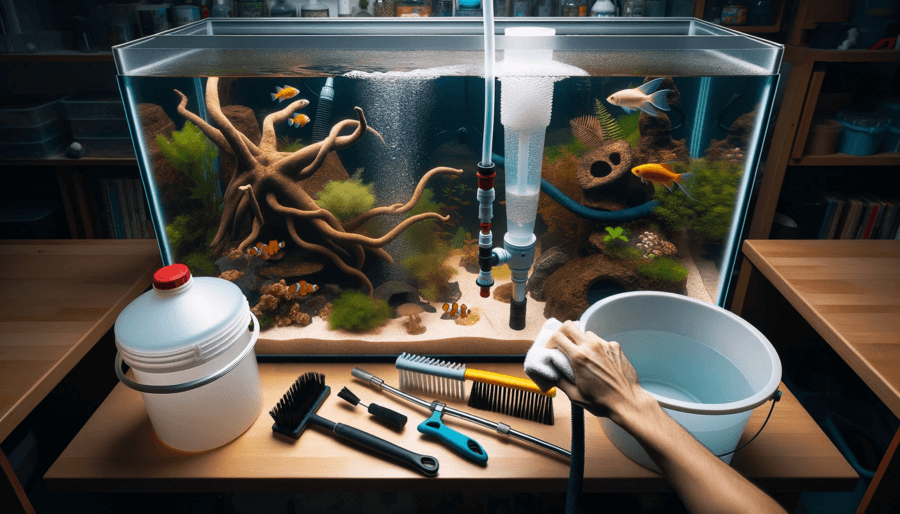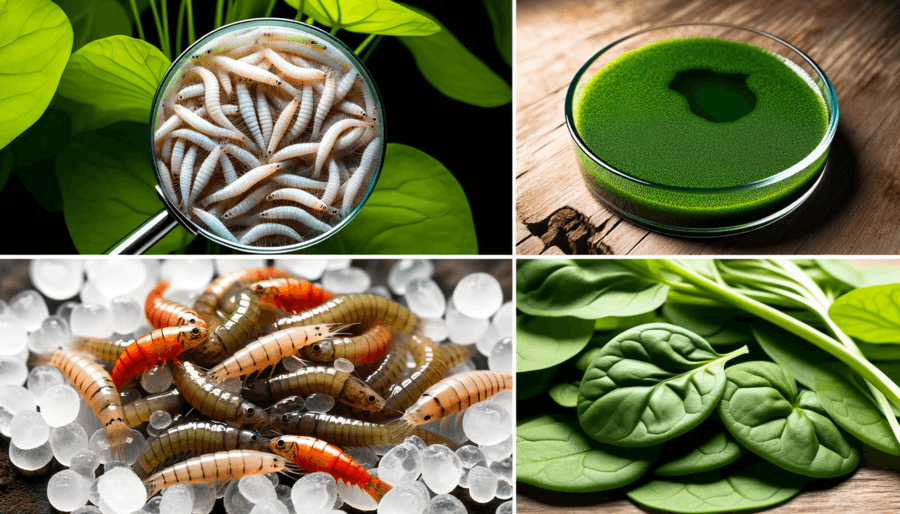What Is The Process Of Cleaning An Aquarium?

If you’ve ever wondered about the process of cleaning an aquarium, look no further! This article will guide you through the necessary steps to maintain a clean and healthy habitat for your underwater friends. From removing debris and algae to maintaining water quality, you’ll learn the essential tasks required to keep your aquarium looking beautiful and your fish thriving. So grab your cleaning supplies and get ready to dive into the world of aquarium maintenance!
Preparing for Cleaning
Before you begin cleaning your aquarium, it’s important to gather all the necessary supplies. This will ensure that you have everything you need at hand and make the cleaning process much smoother. Some essential supplies include a siphon or gravel vacuum, buckets, clean towels or rags, a filter brush or toothbrush, and a water testing kit.
Once you have all your supplies ready, the next step is to check the water parameters. Testing the water will give you an idea of the current conditions in your aquarium. This includes factors such as pH, ammonia levels, nitrate levels, and nitrite levels. It’s important to ensure that these parameters are within the appropriate range for your fish and plants to thrive.
Now that you have all the supplies ready and have checked the water parameters, it’s time to remove the fish and plants from the aquarium. This step is crucial to ensure their safety during the cleaning process. Use a fish net to gently scoop out the fish and place them in a separate container filled with some water from the aquarium. For the plants, carefully remove them from the substrate and place them in a temporary holding container.
Once the fish and plants have been safely removed, it’s time to drain the aquarium. You can use a siphon or gravel vacuum to remove the water from the tank. Start by positioning one end of the siphon in the aquarium and the other end in a bucket or sink. This will allow the water to flow out of the tank through gravity. Take care not to disturb the substrate too much to avoid clouding the water.
Cleaning the Aquarium Equipment
After emptying the aquarium, it’s important to clean the equipment thoroughly. The first item on the list is the filter. Remove the filter media and rinse it in a bucket of aquarium water. Avoid using tap water, as it may contain chlorine or other chemicals harmful to your fish. Gently scrub the filter housing with a brush to remove any buildup or debris. Rinse everything thoroughly before reassembling the filter.
Next, it’s time to clean the gravel or substrate. Use the siphon or gravel vacuum to gently stir the substrate, loosening any debris trapped between the gravel grains. As the siphon sucks up the debris, it will also remove some of the water, helping to maintain cleanliness. Continue this process until you’ve covered the entire gravel bed, ensuring that you don’t remove too much water in the process.
Now it’s time to tackle the glass or acrylic walls of the aquarium. Use an aquarium-safe glass cleaner or a sponge to scrub away any algae or debris. Be gentle to avoid scratching the surface, and rinse the sponge or cloth frequently to avoid spreading dirt. For stubborn algae, you may need to use an algae scraper or magnet cleaner. These tools will help you remove the algae without much effort.
While you’re at it, don’t forget to clean the decorations and aquarium accessories. Remove any ornaments, rocks, or plants from the tank and scrub them gently with a brush or sponge. You can also use an old toothbrush to clean any small crevices or hard-to-reach areas. Rinse everything thoroughly before placing them back in the tank.
Cleaning the Aquarium
With the equipment and decorations clean, it’s time to focus on the aquarium itself. Start by rinsing the aquarium with warm water to remove any remaining debris or residue. Use a clean cloth or sponge to gently scrub the surfaces, ensuring that you reach every corner. Be careful not to use any cleaning agents or soaps, as they may be harmful to your fish.
If you’re dealing with stubborn algae on the glass or acrylic walls, an algae scraper or magnet cleaner will come in handy again. These tools are specifically designed to remove algae without scratching the surface. However, if you’re facing tough stains that won’t come off easily, you can try using vinegar or an algae scrubber. Apply the vinegar or algae scrubber to a cloth or sponge and gently scrub the stained areas. Remember to rinse thoroughly afterward to remove any residue.
During the cleaning process, don’t forget about the rim and cover of the aquarium. Wipe them down with a clean cloth or sponge to remove any dirt or dust that may have accumulated. Remember, every part of the aquarium contributes to its overall cleanliness and appearance.
Refilling and Reassembling
Now that your aquarium is sparkling clean, it’s time to refill it and reassemble all the equipment. Begin by adding fresh water to the tank. Make sure the water is at the appropriate temperature and treated with a water conditioner. The water conditioner will remove any chlorine or harmful chemicals present in tap water, making it safe for your fish and plants.
When refilling the aquarium, be mindful of the water level, ensuring that it matches the needs of your fish and plants. Once the water level is appropriate, you can begin reassembling the equipment. Place the filter back into its housing and reconnect any tubes or hoses. Ensure that the filter is properly primed before turning it back on.
Now it’s time to acclimate the fish and plants back into their clean home. Start by adding a small amount of the new aquarium water to the containers holding the fish and plants. This will help them adjust to the temperature and water conditions. Slowly add more water to the containers over a period of time, allowing the fish and plants to acclimate gradually. This will prevent any sudden changes in water conditions that could stress or harm them.
Maintaining Cleanliness
Once your aquarium is clean and set up, it’s important to establish a routine for maintaining its cleanliness. Regular water testing and maintenance are essential to monitor the water parameters and ensure a healthy environment for your fish and plants. Use a water testing kit to routinely check the pH, ammonia levels, nitrate levels, and nitrite levels. If any parameters are out of range, take appropriate action to correct them.
Partial water changes are another crucial aspect of aquarium maintenance. Regularly replacing a portion of the water helps remove any accumulated toxins, waste, or excess nutrients. Aim to change around 20-25% of the water every one to two weeks, depending on the size and stocking of your aquarium. Remember to treat the fresh water with a water conditioner before adding it to the tank.
In addition to water changes, it’s important to clean the equipment regularly. This includes rinsing the filter media, checking and cleaning the intake and output tubes, and ensuring that the filter is functioning properly. A well-maintained filter plays a vital role in maintaining water quality by removing debris and supporting beneficial bacteria growth.
To prevent overfeeding and waste accumulation, it’s essential to feed your fish only what they can consume within a few minutes. Excess food can contribute to poor water quality and increased algae growth. Additionally, regularly remove any uneaten food to minimize waste accumulation in the aquarium.
Conclusion
Cleaning an aquarium may seem like a daunting task, but with the right approach and tools, it can be a straightforward and rewarding process. By following the steps outlined in this article, you can ensure that your aquarium remains clean and healthy for your fish and plants. Remember to gather all the necessary supplies, check the water parameters, safely remove the fish and plants, drain the tank, clean the equipment, scrub the tank, refill and reassemble everything, and establish a maintenance routine. With proper care and regular maintenance, your aquarium will continue to be a beautiful and thriving ecosystem for years to come.
